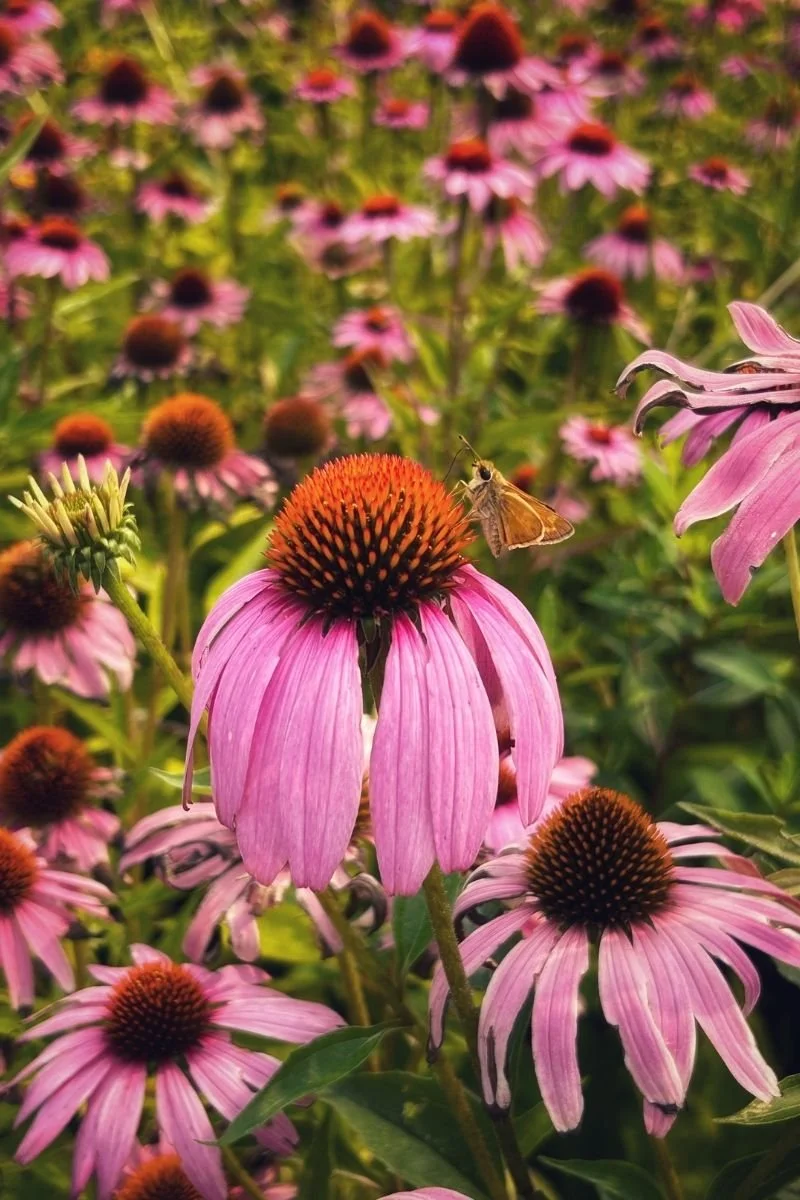Purple Coneflower - A Resilient and Beloved Perennial Plant
The ‘Straight Species’ Echinacea purpurea
In the realm of botanical wonders, purple coneflower (Echinacea purpurea) stands tall as one of the original coneflower species - a hardy perennial plant that covered the prairies and open woodlands of eastern and central North America.
This magnificent plant is a favorite amongst gardeners, herbalists, and nature enthusiasts alike, and was used medicinally by Native American tribes to treat various ailments ranging from fevers to snakebites.
The straight species of Echinacea purpurea refers to the original, naturally occurring, and unaltered form of this particular plant species.
Purple coneflower has captivated generations with its striking petals and iconic cone-shaped center.
Its name, derived from the Greek word "echinos” (meaning hedgehog), aptly describes the spiky appearance of the flower's intricate cone, which is highly attractive to bees, butterflies, and other pollinating insects.
Birds are also drawn to the purple coneflower due to its nutritious and plentiful seeds.
As the flowers mature and the petals begin fade, the seed heads dry and become food for many avian species.
Purple coneflower is remarkably resilient and adaptable; it flourishes in a range of soil conditions, including clay, loam, and sandy soils. It flowers in part shade and withstands heat, humidity, and periods of drought.
Additionally, purple coneflower is easy to propagate by seed or division, allowing for the cultivation of this extraordinary plant in various settings from expansive meadows to cozy garden beds.
Keep scrolling to discover a list of perfect planting companions for this versatile perennial, along with helpful information on its deer resistance and potential problems to look out for.
A skipper butterfly sips nectar from a purple coneflower (Echinacea purpurea).
How Do I Grow Purple Coneflower?
Purple coneflower thrives in full sun (6 hours or more of sunlight a day) and can also grow and flower in part shade or dappled shade.
Ensure the soil drains well; coneflowers like moist, well-draining soil and will become more tolerant of drought once established.
The best time to plant purple coneflower is during the spring or fall. Planting during cooler months allows the plant to establish its roots before the harsh conditions of summer and winter.
Water newly planted purple coneflower plants thoroughly and continue to keep the soil consistently moist during their first growing season. Read our essential guide on How to Water Your Plants for help determining a watering schedule.
However, be careful not to overwater, as this can lead to yellowing leaves and root rot. After the first year, purple coneflower tolerates drought well. Check out the US Drought Monitor Map and keep tabs on drought conditions in your area.
Applying a layer of organic mulch around the plants can help retain moisture and prevent weed growth.
Remove faded blooms regularly throughout the summer months to promote continuous flowering.
In winter, leave the dried flower heads intact, as they provide food for the birds and add visual interest to the winter garden, especially when covered with snow.
Plants can be divided every 3-5 years in early spring or late fall - dig up the root mass, and use a sharp knife or spade to separate the plant into smaller pieces to replant or gift to neighbors.
Is Purple Coneflower Deer Resistant?
Yes, purple coneflower (Echinacea purpurea) is considered deer resistant, with tough, hairy leaves and stems making it less appealing to browsing deer.
Rutgers University rates purple coneflower as “seldom severely damaged” on their List of Landscape Plants Rated by Deer Resistance.
However, no plant is truly deer-proof 😕. When food is scarce, hungry deer will eat almost anything, including plants they typically avoid.
If deer pressure is high in your area, you may still need to take precautions, such as using wire cloches or fences to keep your coneflowers from becoming an unexpected snack.
This mass planting of purple coneflowers shrugs off sidewalk heat, thriving and blooming effortlessly all season long.
What is Wrong with My Purple Coneflower?
Japanese beetles feed on coneflower leaves and leave behind a lacey pattern of holes, with only the leaf veins remaining.
Knocking the beetles off the plant, into a soapy container of water, is an effective solution for getting rid of these unwelcome pests.
Bacterial leaf spot causes brownish-black spots and wilted flowers, and can be prevented by avoiding overcrowded plantings and aiming hose spray towards the roots and soil underneath the plants, not the leaves.
Purple coneflower can also fall victim to the aster yellows disease, a plant pathogen that affects members of the Aster family (Asteraceae) and is transmitted by leafhopper insects.
This fungal infection causes distorted flowers and stunted growth, and the plant becomes weak and frail. Unfortunately, there is no treatment for plants with aster yellows and infected plants should be removed immediately.
Coneflower rosette mite is a new and emerging problem for coneflowers, and the symptoms can look similar to the aster yellows.
Mites living deep inside the plant feed on flowers and stems, causing stunted and distorted growth.
Affected flowers should be cut off and disposed of immediately, taking care not to spread the mites to other parts of the plant or garden.
Planting Companions for Purple Coneflower (Echinacea purpurea):
Black-eyed Susan (Rudbeckia hirta)
Kudos Mandarin Hummingbird Mint (Agastache x Kudos™ ‘Mandarin’)
David Tall Garden Phlox (Phlox paniculata ‘David’)
Karl Foerster Grass (Calamagrostis x acutiflora ‘Karl Foerster’
Moonshine Yarrow (Achillea x ‘Moonshine’)
Lady’s Mantle (Alchemilla mollis)
Hubricht’s Bluestar (Amsonia hubrichtii)
Autumn Fern Brilliance (Dryopteris erythrosora 'Brilliance)
Heavy Metal Blue Switchgrass (Panicum virgatum ‘Heavy Metal’)
Autumn Fire Stonecrop (Sedum telephium ‘Autumn Fire’)
Pink Lemonade False Indigo (Baptisia Decadence® Deluxe ‘Pink Lemonade’)
Floristan White Blazing Star (Liatris spicata ‘Floristan White’)
Hummelo Betony (Stachys officianalis ‘Hummelo’)
Pale Purple Coneflower (Echinacea pallida)
Moonbeam Tickseed (Coreopsis verticillata ‘Moonbeam’)
A mass planting of purple coneflower (Echinacea purpurea) and Black-eyed Susans (Rudbeckia hirta).
Purple Coneflower Garden Ideas:
Purple coneflower looks great when planted in mass, and can be combined with grasses and other summer flowering perennials to create a naturalized, low-maintenance planting.
Plant in mass along a woodland’s edge, to soften the transition from lawn to trees.
Add a row of plants along a sunny, dry strip next to a driveway - after getting established, purple coneflower can handle the heat and humidity radiating off the pavement.
Use purple coneflower in a cutting garden and enjoy the long-lasting flowers in a vase. In fall and winter, use the dried seed heads to bring texture to dried flower arrangements.
Liven up a privacy screen of Emerald Green arborvitae (Thuja occidentalis ‘Smaragd’) by planting a row of purple coneflower along the front, or use in a border garden to anchor the back corners.
The high wildlife value of purple coneflower makes it a great addition to any butterfly, pollinator, or bird garden.
Create a native garden with four seasons of interest by combining purple coneflower with a serviceberry/shadbush tree (Amelanchier arborea), moss phlox (Phlox subulata), Moonshine yarrow (Achillea x ‘Moonshine’), white wood aster (Aster divaricatus), Gem Box® inkberry holly (Ilex glabra ‘SMNIGAB17’ Gem Box®), and Red Sprite winterberry holly (Ilex verticillata ‘Red Sprite’). In order for the Red Sprite winterberry holly to produce berries, be sure to plant an early-flowering male pollinator nearby, such as ‘Jim Dandy’.



